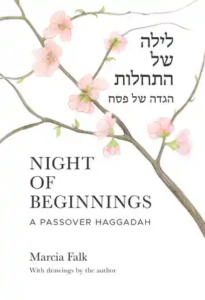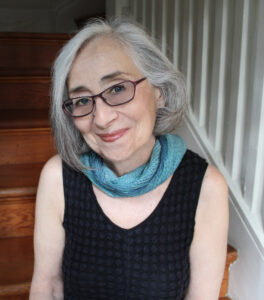The Mordecai M. Kaplan Center for Jewish Peoplehood is proud to have underwritten the production costs of Marcia Falk’s new haggadah, Night of Beginnings. In the essay below—excerpted from the Introduction to that haggadah—Falk presents her goals in writing the haggadah and surveys its unique features.
 The intention of Night of Beginnings is to do more than “update” the traditional liturgy, to do more than make it consonant with contemporary thinking and sensibilities. This haggadah is an attempt to go beyond these aims to reveal meanings beneath the surface of the Pesach ritual and to deepen our personal connections to the holiday.
The intention of Night of Beginnings is to do more than “update” the traditional liturgy, to do more than make it consonant with contemporary thinking and sensibilities. This haggadah is an attempt to go beyond these aims to reveal meanings beneath the surface of the Pesach ritual and to deepen our personal connections to the holiday.
In our times, we have seen a profusion of different kinds of haggadot. And yet, strikingly, one is hard-pressed to find in any haggadah, ancient or modern, a full recounting of the biblical story. It is doubly ironic that, although the word-root of both haggadah and Maggid (the central portion of this haggadah) means “telling,” the standard haggadah does not actually tell the Exodus story—in fact, it does not offer a continuous narrative at all. Instead, it provides tastings—rabbinic anecdotes, comments, and exhortations, punctuated with biblical quotations—that show us how the generations of rabbis who created and redacted the haggadah viewed the purpose and meaning of the Pesach festival and how they wanted us to view and observe it. For many of us, this compilation fails to engage the way that stories do and fails to draw us deeply into our own search for the festival’s meaning.
In recounting the full Bible story, Night of Beginnings seeks to provide a more direct connection to the origins of the holiday. “Maggid: The Telling”— which is not only the centerpiece of this haggadah but one of its three main innovative elements—offers a compressed version of the Exodus narrative, beginning with the Israelites’ enslavement and ending with their crossing the Sea of Reeds. Presented this way, the narrative is revealed to have a dramatic trajectory with an opening, a climax, and a denouement. No attempt has been made here to make the character of God gender-inclusive; in the Exodus story God is decidedly male, and it is this story that we investigate and seek to understand in all its complexity, on seder night. Importantly, unlike the standard haggadah, which omits any mention of the story’s main human protagonists, “Maggid: The Telling” includes the voices and actions not just of Moshe and his brother, Aaron, but of the female characters, among them Moshe’s mother; his sister, Miriam; Pharaoh’s daughter, who adopts the baby Moshe; and the midwives Shifrah and Pu’ah, who save the lives of Hebrew male infants. Interspersed throughout the narration is a new commentary, indicated in bold letters, that raises questions of interpretation and invites us to bring our personal experiences into the discussion.
Besides “Maggid: The Telling,” Night of Beginnings offers two other major innovations: new b’rakhot (plural of b’rakhah, blessing), which are re-creations, in Hebrew and in English, of the traditional blessings; and kavanot (plural of kavanah, intention, or direction of the heart), a genre that is entirely new to the seder ritual.
 The new b’rakhot express a theology that differs distinctly from that of the traditional rabbinic blessings as well as from that of the Bible story. They envision the divine—the ineffable, the sacred—as a greater whole of which we are an inseparable part. They convey this vision with images—new metaphors, such as eyn haḥayim (wellspring of life) and ma’yan ḥayéynu (flow of our lives)—that replace the depiction of God as a lord and king. These new metaphors are neither anthropomorphic (not male and not female) nor abstract, but drawn largely from the natural world. Their inclusive language makes room for women to find and use our voices more full-throatedly than we were able to do with the patriarchal prayers we inherited from the early rabbis.
The new b’rakhot express a theology that differs distinctly from that of the traditional rabbinic blessings as well as from that of the Bible story. They envision the divine—the ineffable, the sacred—as a greater whole of which we are an inseparable part. They convey this vision with images—new metaphors, such as eyn haḥayim (wellspring of life) and ma’yan ḥayéynu (flow of our lives)—that replace the depiction of God as a lord and king. These new metaphors are neither anthropomorphic (not male and not female) nor abstract, but drawn largely from the natural world. Their inclusive language makes room for women to find and use our voices more full-throatedly than we were able to do with the patriarchal prayers we inherited from the early rabbis.
In addition to offering new imagery, the b’rakhot differ from rabbinic prayer in their mode of address: rather than passively acknowledging a “blessed You,” they open with inclusive, active verbs, such as n’varekh (let us bless) and nodeh (let us thank), calling upon us, the human community, to perform the act of blessing. Some of the b’rakhot open directly with an image, leaving the invocation implied. Each b’rakhah is introduced with a quotation from Tanakh, linking it to our most ancient texts. All the b’rakhot ask that we bring our attention to the fullness of the moment and, at times, that we commit to fulfilling the words of the blessing with action, not just ritually but in the acts of our ordinary daily lives. B’rakhot are the core of every seder ritual, as they are in this haggadah; simply put, without them there is no seder.
The kavanot in Night of Beginnings amplify the b’rakhot, and we might think of them as the seder’s heart. If the b’rakhot are short lyric poems that touch down lightly on single moments—the lighting of candles, the eating of matzah—the kavanot take the form of longer prose-poems and meditations, inviting us to delve more deeply and broadly, lingering over images, themes, and motifs, and allowing ourselves to enter more fully and more personally into the experience of the night.
Interspersed among the three main innovative elements of this haggadah—the b’rakhot, the kavanot, and the Maggid—are several kinds of embellishments: poems, psalms, and songs, as well as traditional readings that are usually sung, including Arba Hakushyot (the Four Questions), Sh’faḥot Va’avadim Hayínu (Once We Were Slaves), Ha Laḥma Anya (This Is the Bread of Affliction), B’khol Dor Vador (In Every Generation), and Dayénu (It Would Have Been Enough). All of these readings, with the exception of Dayénu, have been adapted to make them more inclusive. The traditional songs that follow the seder proper have, like Dayénu, been left unaltered for the sake of maintaining their “singability.” In the words of Rabbi Ira Eisenstein z”l, we sing these “as quotation rather than affirmation.” Some of the traditional readings have been moved from their usual places in the haggadah; rather than being scattered throughout, they are clustered in two sections that frame the Maggid: “Before the Maggid: Preparing to Listen” and “After the Maggid: Celebrating the Story.” These modifications to the structure of the standard haggadah lend coherence to what has felt, to many people, like a less-than-unified creation.
Underlying many aspects of Night of Beginnings is the motif of hiddenness-and-uncovering. In “Maggid: The Telling,” this motif is recurrent: Moshe starts life hidden in a basket in the Nile, and over the course of the narrative he becomes a prominent leader and a prophet. This progression from the concealed and inchoate to a revealed identity parallels the emergence of the Israelites from enslavement into peoplehood. So too, in Exodus 3 God reveals His heretofore hidden name—Ehyeh-Asher-Ehyeh (I Am That I Am)—to Moshe for the first time.
The framework of the seder ritual echoes this motif. Near the start of the seder, the leader hides the afikoman (a broken-off piece of matzah) and, toward the end of the meal, the afikoman—essential for concluding the seder—is found.
In an essay entitled “Revealment and Concealment in Language,” the great twentieth-century Hebrew poet Hayim Nahman Bialik wrote of how language conceals truths and yet how, paradoxically, when crafted as poetry, language can reveal the hidden core of things. Night of Beginnings speaks, in large part, in the language of poetry—with b’rakhot and lyric poems created specially for the seder, kavanot that take the form of prose poems, biblical psalms, readings from the Song of Songs, and modern poems. This assemblage of poetic modes will, I hope, serve to uncover meanings and nuances that might otherwise be buried or obscured. This is a poet’s Passover, and as we read aloud from it, we all partake in poetry’s power to reveal. In this sense, on seder night, we are all poets.
The theme of concealment and revealment embedded in Night of Beginnings has implications for our personal attainment of freedom. Self-awareness—being revealed to oneself—is a necessary (though not sufficient) condition for freedom. The less one is hidden from oneself, the greater one’s potential for self-actualization, the fruit of a freely chosen life. And the greater one’s freedom, the better one’s ability to pursue freedom and justice in the world. Self-awareness is not just a necessary condition for personal freedom; it is the grounding of one’s awareness of the needs of others—the first step in the journey out of the wilderness.
